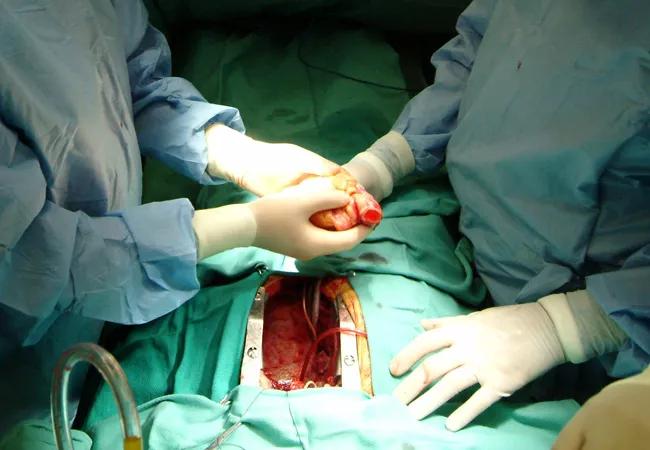Largest study to date confirms mortality rates similar to DBD transplant and reveals risk factors

The largest study to date on donation after circulatory death (DCD) heart transplant confirms that the procedure has one-year survival rates similar to donation after brain death (DBD) heart transplant. In addition, the report by the International Society for Heart and Lung Transplantation (ISHLT) is the first to identify mortality risk factors of DCD heart transplant.
Advertisement
Cleveland Clinic is a non-profit academic medical center. Advertising on our site helps support our mission. We do not endorse non-Cleveland Clinic products or services. Policy
“Risk factors were previously unexplored because we didn’t have a cohort big enough to produce enough data,” says the ISHLT report’s lead author Eileen Hsich, MD, Medical Director of Heart Transplantation at Cleveland Clinic. “By combining data from around the world, we were finally able to determine what drives mortality after DCD heart transplant.”
Early death after transplant is rare, she notes. In the U.S., which performs more heart transplant procedures than any other country, 92% of transplant recipients live beyond the first year, according to the Scientific Registry of Transplant Recipients.
“DCD heart transplantation has expanded the donor pool worldwide with similar survival to DBD heart transplantation,” says Edward Soltesz, MD, MPH, Surgical Director of Cleveland Clinic’s Kaufman Center for Heart Failure Treatment and Recovery. “Cleveland Clinic has adopted strategies like DCD that increase the donor pool and innovations that improve donor organ transport preservation to ensure we can save lives and provide the best care for our patients on the waiting list.”
The rising use of DCD heart transplant — fueled by reports of favorable outcomes at centers in Australia, the U.K. and the U.S. — has helped expand the donor pool and increase the volume of heart transplant procedures.
DCD heart transplant requires advanced donor organ transport systems, such as temperature-controlled transport or ex-vivo perfusion. These newer technologies enable the donor heart to travel farther distances over longer spans of time, no longer limited to four hours of preservation with cold ischemic storage.
Advertisement
“In recent years, increased-risk donors helped boost our transplant numbers, but we have nearly maximized that potential,” Dr. Hsich says. “Now DCD heart transplant could increase transplants by another 20%. However, most countries, including the U.S., have not yet achieved that.”
According to the recent ISHLT report, based on more than 22,000 patients worldwide who received heart transplants between 2015 and 2024, DCD makes up only 8.8% of heart transplants in North America. In Europe, the rate is closer to 19%, at least for the centers that report data to the ISHLT. All U.S. heart transplant centers are represented in ISHLT data.
“Other regions report up to 24% of heart transplants performed with DCD hearts, so use varies greatly across geographic regions,” Dr. Hsich says.
Overall, DCD heart transplantation has steadily increased over time, as shown in the table below.
| Heart transplants with DCD hearts | |
|---|---|
| 2015-2019 | 3.6% |
| 2020-2021 | 5.6% |
| 2022-2024 | 14.6% |
| 2015-2019 | |
| Heart transplants with DCD hearts | |
| 3.6% | |
| 2020-2021 | |
| Heart transplants with DCD hearts | |
| 5.6% | |
| 2022-2024 | |
| Heart transplants with DCD hearts | |
| 14.6% |
“The innovations in organ recovery and transport methods that have made DCD heart transplantation a reality in the U.S. represent a very important advance supporting timely access to donor hearts for our patients on the waiting list,” says cardiologist Amanda Vest, MBBS, Section Head of Heart Failure and Recovery at Cleveland Clinic. “Cleveland Clinic’s adult heart transplant program is committed to exploring new opportunities that enable us to match donor hearts for as many patients awaiting transplants as possible.”
Based on nearly 1,500 DCD heart transplant recipients and nearly 15,000 DBD heart transplant recipients worldwide in the ISHLT survival analysis, there was no significant difference in survival rates at one year between donor types. Both groups had approximately 92% survival at one year.
Advertisement
Variables associated with higher one-year mortality after DCD heart transplant were:
The continuing advancement of DCD heart transplant requires international collaboration, says Dr. Hsich. “That is what the ISHLT registry makes possible — offering a unique and valuable opportunity to share and monitor transplant innovations around the globe.”
By compiling worldwide data, researchers can study DCD heart transplantation in more depth, with more granular data or with more analytical power, she says. Such was the case with the recent ISHLT report, which produced findings on DCD heart transplant not possible with smaller cohort studies.
“No single nation can make progress alone, not even the U.S., which reports the most transplant volume,” Dr. Hsich says. “We need insights from every center involved in DCD everywhere. The concept originated in South Africa, was pioneered in Australia and was refined in the U.K., paving the way for further exploration in the U.S. The organ transport devices that make DCD possible were developed internationally. For the world to continue to make headway in increasing heart transplants and reducing wait list mortality, it will take all of us working together.”
Advertisement
Advertisement
Advertisement

Insights on bringing Cleveland Clinic even closer to becoming the best transplant enterprise in the world

Consensus statement aims to increase use of the perfusion technology and raise transplant volumes

Minimally invasive approach, peri- and postoperative protocols reduce risk and recovery time for these rare, magnanimous two-time donors

Minimally invasive pancreas-kidney replacement reduces patient’s pain, expedites recovery

Patient receives liver transplant and a new lease on life

More than 30% of patients die when early dialysis is needed after surgery

AHA recommendations for pretransplant evaluation, peritransplant and long-term management

Highlights and insights from recent Cleveland Clinic experience